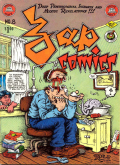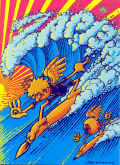Zap Comics

ZAP COMICS
Last Gasp (1967-88)
Zap Comix was an underground comix series which was originally part of the youth counterculture of the late 1960s. While a few small-circulation self-published satirical comic books had been printed prior to this, Zap became the model for the “comix” movement that snowballed after its release. The title itself published 17 issues over a period of 46 years. The first 15, from the classic period, are posted here.
Premiering in early 1968 as a showcase for the work of Robert Crumb, Zap was unlike any comic book sensibility that had been seen before. After the success of the first issue, Crumb opened the pages of Zap to several other artists, including S. Clay Wilson, Robert Williams, “Spain” Rodriguez, Gilbert Shelton, and two artists with reputations as psychedelic poster designers, Victor Moscoso and Rick Griffin. This group of artists, along with Crumb, remained mostly constant throughout the history of Zap. While the origin of the spelling “comix” is a subject of some dispute, it was popularized by its appearance in the title of the first issues of Zap. Design critic Steven Heller claims that the term “comix” (“co-mix”) refers to the traditional comic book style of Zap, and its mixture of dirty jokes and storylines.
Labeled “Fair Warning: For Adult Intellectuals Only”, Zap #1 featured the publishing debut of Robert Crumb’s much-bootlegged Keep on Truckin’ imagery, an early appearance of unreliable holy man Mr. Natural and his neurotic disciple Flakey Foont, and the first of innumerable self-caricatures (in which Crumb calls himself “a raving lunatic”, and “one of the world’s last great medieval thinkers”). The debut issue included the story “Whiteman”, which detailed the inner torment seething within the lusty, fearful heart of an outwardly upright American. For the second issue, Crumb invited S. Clay Wilson, Victor Moscoso and Rick Griffin to contribute. Gilbert Shelton joined the crew with issue #3, and Robert Wiliams and Spain Rodriguez joined with issue #4, completing the roster.
Zap’s new publisher the Print Mint weathered a lawsuit filed over the Zap #4, released in 1969, which featured among other things, Crumb’s depiction of incest in a middle-class family. The publishers, Don & Alice Schenker, were arrested and charged with publishing pornography by the Berkeley Police Department. Previous to that, Simon Lowinsky, who had a gallery on College Avenue in Berkeley and had put up an exhibition of the Crumb’s original drawings, had been arrested on the same charge. His case came to trial first. He was acquitted[3] after supportive testimony from Peter Selz, a prominent figure in the art world. At that point the city dropped the charges against the Print Mint.[citation needed] In a related case, however — also brought on by Zap #4 — the U.S. Supreme Court ruled in 1973 that local communities could decide their own First Amendment standards with reference to obscenity. In the mid-1970s, sale of drug paraphernalia was outlawed in many places, and the distribution network for these comics (and the underground newspapers) dried up, leaving mail order as the only commercial outlet for underground titles.
Contributor Rick Griffin died in 1991; Paul Mavrides (Furry Freak Brothers) made his debut as a Zap contributor in issue #14 (1998). Mavrides was invited to contribute when Crumb announced that he no longer wanted to work on Zap, although Crumb never did actually quit the title.















